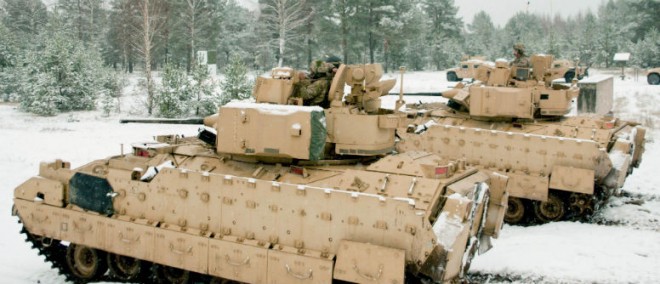US Army may station tanks in Eastern Europe–general

This November 21, 2014 US Army handout photo shows M2A3 Bradley Fighting Vehicles from Company A, 2nd Battalion, 8th Cavalry Regiment, 1st Brigade Combat Team, 1st Cavalry Division, preparing to start a live-fire training exercise at Adazi Training Area, Latvia as part of the US Army Europe-led Operation Atlantic Resolve land force assurance training exercise. The US Army plans to deploy about 150 tanks and armored vehicles to NATO countries next year and some of the heavy armor may be stationed in Eastern Europe, a top American general said November 25, 2014. AFP / Handout / US Army Army / Staff Sgt. Kenneth C. Upsall
The US Army plans to deploy about 150 tanks and armored vehicles to NATO countries next year and some of the heavy armor may be stationed in Eastern Europe, a top American general said Tuesday.
The move is part of a US effort dubbed “Operation Atlantic Resolve” in the Baltic states and Poland to reassure allies anxious about a resurgent Russia, with American troops deploying for several months at a time to conduct joint exercises.
Nearly 50 armored vehicles are already in place and another 100 M1 Abrams tanks and Bradley fighting vehicles will be “pre-positioned” in Germany and possibly elsewhere for the US troops conducting drills with NATO partners, Lieutenant General Ben Hodges told AFP in a phone interview from Estonia.
“The troops will come over and train, and they’ll go back. The equipment will stay behind,” Hodges said.
The arrangement was “a lot cheaper” than transporting tanks across the Atlantic and more efficient for the training mission, the general said.
Hodges said he would soon make a recommendation on whether to store some of the tanks and armored vehicles among NATO’s eastern members.
“I’m going to look at options that would include distributing this equipment in smaller sets, company-size or battalion-size, perhaps in the Baltics, Poland, Romania, Bulgaria, places like that,” he said.
‘Closest to the threat’
The United States has about 29,000 forces permanently stationed in Germany, Italy and Belgium but has stepped up temporary deployments of troops for training and exercises designed to send a signal to Russia and NATO partners.
The exercises are meant “to provide assurance to those allies that are closest to the threat,” the general said.
About 600 US Army troops from the 1st Cavalry Division are to depart in mid-December after a three month stint in the Baltic countries and Poland. They will be replaced by soldiers from the 2nd Cavalry Regiment based in Vilseck, Germany, who then will hand over in the spring to members of the 3rd Infantry Division, he said.
Hodges, who took over as head of US Army forces in Europe three weeks ago, said the troop rotations will continue through 2015 and into 2016, saying: “This is going to go on.”
Russia’s annexation of the Crimean peninsula and its backing of rebels in eastern Ukraine has sparked grave concern in a region scarred by decades of Soviet occupation, and the arrival of American troops has received an overwhelming welcome, he said.
“I was in Lithuania yesterday, Estonia today, Poland a few weeks back. All I get is ‘thank you, thank you, thank you’ from those host nations for what these soldiers represent.”
RELATED STORIES
Russia gets greater control over Black Sea region
Ukraine signs deal to align itself with Europe